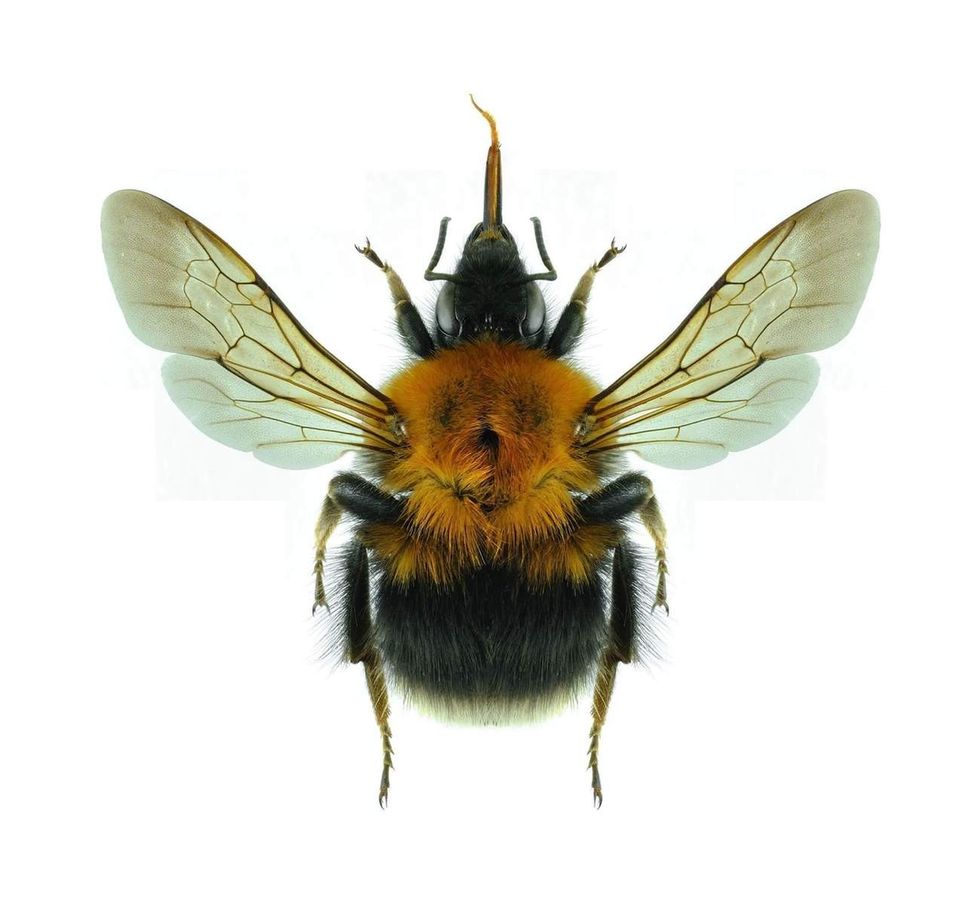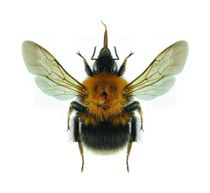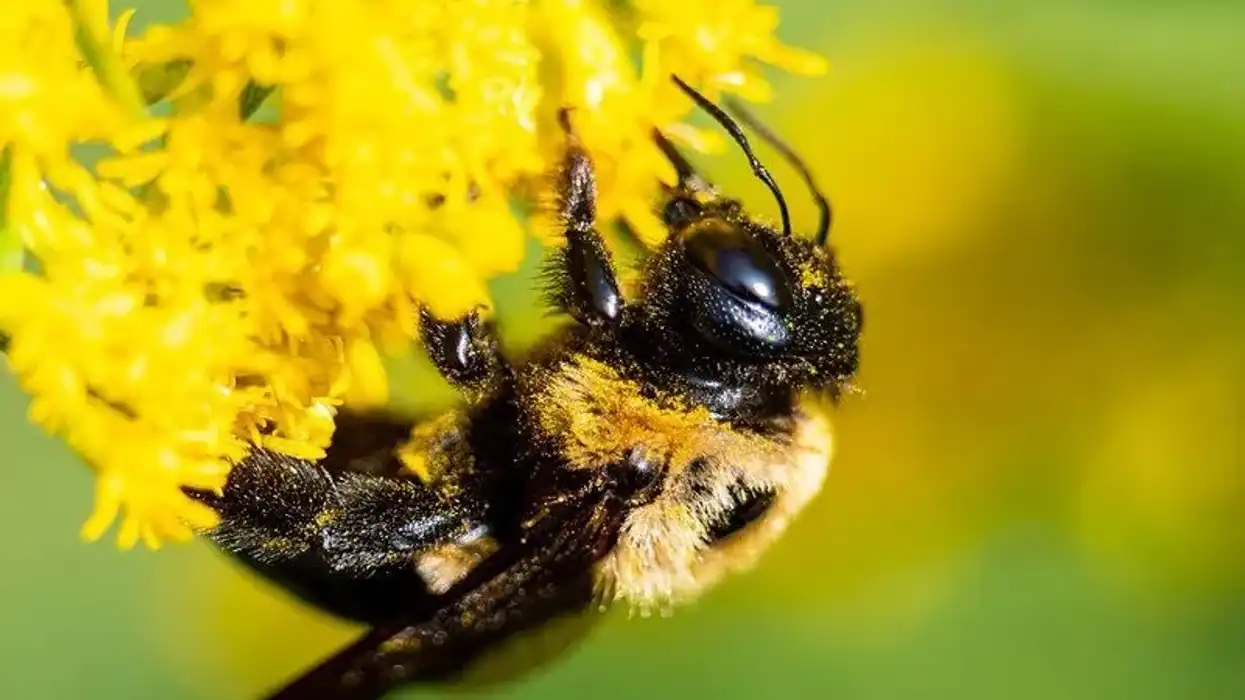The tree bumblebee is a bee common in Europe and parts of Asia. It is found in the north of France, Russia, the Pyrenees, the Balkans, Greece, Iberia, Scotland, Iceland, England, and Wales.
The tree bumblebee was first recorded in the British territories of Scotland and England in 2007. The tree bumblebee species likes to live in urban areas and close to human settlements, often in bird boxes.
The nests are usually above the ground. Apart from bird boxes and human-inhabited areas, tree bumblebees are also seen in forests, but with lesser trees. Tree bumblebees live in large nests with 150-400 bees.
They mate, copulate and lay eggs to reproduce. The worker bees live for around four weeks and the queens can live for up to a year.
They have hair on the thorax and abdomen that are distinctively ginger and black along with a white tail. They are a Least Concern species according to the IUCN Red List.
For more relatable content, check out these honey bee interesting facts and stingless bee facts for kids.
Tree Bumblebee Interesting Facts
What type of animal is a tree bumblebee?
The tree bumblebee (Bombus hypnorum) is an insect and a bee.
What class of animal does a tree bumblebee belong to?
The tree bumblebee (Bombus hypnorum) belongs to the Insecta class of animals.
How many tree bumblebees are there in the world?
The exact number of tree bumblebees in the world is unknown since these white-tail-having bees are common in their geographic range map.
Where does a tree bumblebee live?
The tree bumblebee species is common in the regions of the north and continental Europe. Tree bumblebees are found in northern France stretching to Russia's Kamchatka towards the east. The wide range map continues from the north European mountains to the Pyrenees. Among the Balkans, it is found in Greece, in its northwestern parts.
The tree bumblebees are also seen in the Iberian Peninsula's mountains. The tree bumblebees have also been observed in the United Kingdom since 2001, first recorded in Wiltshire's Landford village.
They have kept spreading in the UK since, having been observed in Scotland, England, and Wales. The bees have also been seen in Iceland, first recorded in 2008. This recent arrival and spread of new queens and worker bees in the northern distribution range is likely to keep spreading and thriving in the human settlements of Iceland, especially Reykjavík.
What is a tree bumblebee habitat?
The tree bumblebee likes living near human settlements and urban areas. The nest is built above the ground. Tree bumblebees also live in bird boxes.
They also like forests, but ones with fewer trees. Walls and holes of trees are preferred in the natural habitat where the support of bird boxes isn't available. Any recent arrival of new queens in urban habitats spreads quickly.
Whom do tree bumblebees live with?
Tree bumblebees live in large nesting spaces in bird boxes and tree holes with 150-400 worker bees.
How long does a tree bumblebee live?
The worker bees of the tree bumblebee species live an average of four weeks and the queens can live up to an entire year.
How do they reproduce?
There are two stages involved, the approach to mate and then the copulation. The mandibular gland on the queens sends out a pheromone that relays its receptiveness to copulation. Copulation lasts for 20-40 minutes.
If the queens feed well, they are ready to lay some eggs. The eggs get fertilized on their way out of the body of the queens, utilizing the sperm stored from the copulation.
Sixteen eggs are placed by queens inside 'pollen balls' sealed with wax. The eggs of the queens are creamy and sausage-shaped. They need to be kept warm by the queens and the larvae are born within four days.
The larvae molt thrice within 12-14 days. Before queen or worker bees emerge, a cocoon is spun by the larvae, within which metamorphosis and pupation occur, after which there is an arrival of brown-ginger bees that emerge.
What is their conservation status?
The conservation status of the tree bumblebee species according to the International Union for Conservation of Nature is Least Concern.
Tree Bumblebee Fun Facts
What does the tree bumblebee look like?
The tree bumblebee species tends to have a rounded head and a small proboscis. The thorax is usually ginger-colored but it can be black or dark in some cases. A brown thorax is also observed.
They have a black abdomen and a white tail as well. In the worker bumblebees, the abdominal segment or the first tergite has black hair. But some males have ginger hairs along with dark or black hairs, on the black abdomen tergum as well as on the face.
The European tree bumblebees have yellow extended coloration too. The worker bees tend to be smaller and the drones are bigger. The queen tree bumblebee size is variable.
How cute are they?
Tree bumblebees are adorable and cute, but their stings can be discomforting. These tiny creatures have delicate wings and gorgeous ginger-black coloration along with a white tail. They are beautiful to look at in flight.
How do they communicate?
Tree bumblebees are social and communicate via vision, touch, pheromones, as well as wing vibrations. The safety of a nest and the location of food are among the things communicated. Tree bumblebees can also see ultraviolet light.
How big is a tree bumblebee?
Tree bumblebees are 0.6-1 in (1.5-2.5 cm) long, which makes them six times smaller than titan beetles.
How fast can a tree bumblebee fly?
Tree bumblebees have a flight speed of 6.7-10.7 mph (10.8-17.2 kph).
How much does a tree bumblebee weigh?
A tree bumblebee weighs 0.0014-0.03 oz (0.04-0.85 g).
What are the male and female names of the species?
The male tree bumblebees are called drones whereas the females can be workers or a queen, depending on their social role.
What would you call a baby tree bumblebee?
A baby tree bumble-bee is called a larva or a brood.
What do they eat?
Tree bumblebees eat the nectar of flowers and pollen. They eat the nectar and visit the flowers of comfrey, fruit trees, shrubs like brambles, fuscia, cotoneaster, blackthorns, ground-ivy, white nettle, and other garden plants.
Their predators include various species, spiders, flies, great tits, bee-eaters, shrikes, great gray shrike, and European honey buzzard.
Are they dangerous?
Tree bumblebees aren't particularly dangerous, they only sting if their nesting sites are threatened. The male bees don't even have a stinger. Some people have an allergic reaction to a tree bumblebee sting and most local reactions involve some pain, redness, swelling, and itching.
Would they make a good pet?
No, they would not make good pets as they generally don't like being petted. Since these black-abdomen-having bees favor urban areas, a tree bumblebee in-house is not uncommon and harmless.
Did you know...
Tree bumblebees are enormously important to many ecosystems since these white-tail-having bees visit many different flowering plants like Rhododendron, grape hyacinth, cherry, Vaccinium, and blueberry.
Tree bumblebees can be identified with their ginger-brown and dark colorations. The sometimes brown thorax may mostly seem ginger-colored. These black-abdomen-having bees were first recorded further north than usual in 2007-08 in Britain and Iceland but their true distribution range may be even wider with a possible recent arrival in many territories.
The Bumblebee Conservation Trust charity in Britain is the only registered charity dedicated to the support and conservation of tree bumblebees and other bumblebees.
Along with the British territories of Scotland, England, and Wales habitats, a tree bumblebee Ireland arrival and spread have also been observed.
A tree bumblebee colony is most active from March to June or July. June to July is the end of one cycle.
How long does a tree bumblebee nest last?
Tree bumble-bee nests in the bird boxes and tree holes last for around three to four months.
Do tree bumblebees sting?
Tree bumblebees only sting if they feel their nests are being threatened.
Here at Kidadl, we have carefully created lots of interesting family-friendly animal facts for everyone to discover! Learn more about some other insects from our sweat bee fun facts for kids and dragonfly interesting facts pages.
You can even occupy yourself at home by coloring in one of our free printable shrill carder bee coloring pages.









